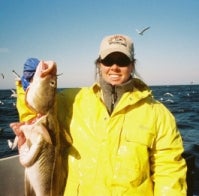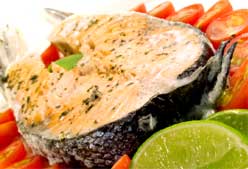 Two very thoughtful articles came out of New England earlier this week, both talking about the current difficulties groundfish fishermen are having in staying afloat financially under the current fisheries management system (1, 2). Both pieces make the case that it is not catch shares but low catch limits (i.e., not enough fish to go around) that is causing such hardship, and that sectors provide fishermen with a better chance to stay solvent while fisheries recover.
Two very thoughtful articles came out of New England earlier this week, both talking about the current difficulties groundfish fishermen are having in staying afloat financially under the current fisheries management system (1, 2). Both pieces make the case that it is not catch shares but low catch limits (i.e., not enough fish to go around) that is causing such hardship, and that sectors provide fishermen with a better chance to stay solvent while fisheries recover.
I have consistently found John Sackton of Seafood.com and John Richardson of the Portland Press Herald to be two of the most nuanced, insightful reporters covering the New England fishing industry. They have each clearly been writing about this for years, care about what happens, and provide a perspective and context to current events that move my understanding forward.
EDFish
Insightful Articles on New England Sectors
Kate Bonzon Responds to the Pew Catch Share Report
 I was hoping the Pew Environment Group’s new report, Design Matters: Making Catch Shares Work would provide some good information about how to design catch shares, but instead I found it over-simplistic, somewhat confusing and lacking any new insight into catch shares and effective design. Just about everyone agrees that catch shares can and should be designed for the unique needs of fisheries and the communities that depend on them.
I was hoping the Pew Environment Group’s new report, Design Matters: Making Catch Shares Work would provide some good information about how to design catch shares, but instead I found it over-simplistic, somewhat confusing and lacking any new insight into catch shares and effective design. Just about everyone agrees that catch shares can and should be designed for the unique needs of fisheries and the communities that depend on them.
EDF has been working on catch share design for years, and recently released a 100+ page draft of a Catch Shares Design Manual that outlines a roadmap for designing catch shares based on experience from around the world. (After an open peer review is done, we’ll finalize the manual.) I agree with the title of Pew’s report. Design of catch shares does matter. It matters a lot.
The overall feeling I left with was that Pew is comparing catch shares to an ideal world that doesn’t exist rather than to the reality of current management. The report identified many issues that traditional management hasn’t solved, and makes the case that catch shares should solve all of those problems.
The good news is that catch shares generally do make progress on those problems—and as they are adjusted over time they get even better. These include setting an accurate, science-based cap, establishing an appropriate monitoring and enforcement program, managing multiple species, reducing bycatch and habitat destruction, and compensating fishermen who are caught in a system that has led to over-capitalization.
Pew is right that these are tough problems for fisheries, but they neglect to mention that catch shares are better at achieving positive outcomes than nearly any other management approach currently in use. For example, Pew says:
“In some fisheries, improvements were more likely the result of hard TAC limits than an IFQ system.”
What they failed to mention is that not only are catch share fisheries more likely to have a hard catch limit, but fishermen are also far more likely to stay within the identified catch limits. And, the science behind those catch limits is also dramatically better than it was before catch shares were implemented. In short, catch shares lead to more accurate science-based catch limits and fishermen who come in below catch limits, 5% on average.
Nobel Prize Winning Economist–Did She Really Take a Side?
 When Nobel Prize winners speak, people tend to listen. Recent economics prize winner Elinor Ostrom was cited “for her analysis of economic governance, especially the commons.” The governance of the commons is exactly the problem we face in fisheries—in the United States and the world.
When Nobel Prize winners speak, people tend to listen. Recent economics prize winner Elinor Ostrom was cited “for her analysis of economic governance, especially the commons.” The governance of the commons is exactly the problem we face in fisheries—in the United States and the world.
This week Dr. Ostrom has been quoted in the catch shares debate in New England—and the quotes did not sound to me like the work that Dr. Ostrom has done. So we at EDF asked her what she thought. Here is what she said:
“I am quite distressed to find that I am being characterized as supporting or opposing particular policies to manage fisheries in New England. To be clear, I have not taken a side in this debate.
“Fishermen and fishing communities all over the world are facing loss of the ocean resources that they depend on. What my work and the work of other scholars shows above all is that the issues involved in managing natural resources are complex. A range of approaches have worked in different places and under different circumstances.
“I have not yet had the opportunity to study the “sectors” approach in detail, and so do not have a view on how it is likely to perform. What we can be confident of is that reducing overfishing and achieving sustainability for the long run will require good-faith effort, hard work, and cooperation among local communities and government authorities.”
Seafood Choices, Helpful Tools from EDF and Monterey Bay Aquarium
 Last week, as part of its 25th anniversary celebration, the Monterey Bay Aquarium’s Seafood Watch program released a report entitled, “Turning the Tide: The State of Seafood.” It outlines the challenges and opportunities facing the global seafood industry, and how consumers, businesses and policy makers in North America can make a difference in the health of our oceans.
Last week, as part of its 25th anniversary celebration, the Monterey Bay Aquarium’s Seafood Watch program released a report entitled, “Turning the Tide: The State of Seafood.” It outlines the challenges and opportunities facing the global seafood industry, and how consumers, businesses and policy makers in North America can make a difference in the health of our oceans.
One piece of the report that was covered extensively, was the creation of a “Super Green” list of seafood choices, which are both fished or farmed responsibly AND good for your health. I worked with the Aquarium over the last several months to develop and refine this list based on EDF’s extensive research on the topic. Here are the best choices that we identified:
- Albacore Tuna (from the U.S. or British Columbia)
- Mussels (farmed)
- Oysters (farmed)
- Pacific Sardines
- Pink Shrimp (from Oregon)
- Rainbow Trout (farmed)
- Salmon (from Alaska)
- Spot Prawns (from British Columbia)
A second tier of good choices with slightly lower, but still beneficial levels of omega-3s includes Arctic char, farmed bay scallops, U.S. crawfish, Dungeness crab, U.S. longfin squid, and longline-caught Pacific cod from Alaska.
Too often the debate around this issue is portrayed as black and white – either that all seafood is healthy and should be consumed whenever possible, or that it’s all contaminated and we should get our omega-3s from sources other than fish. Well we now know that that doesn’t have to be the case. You can still enjoy the health benefits of seafood consumption, while minimizing your exposure to contaminants and supporting responsible fisheries and aquaculture operations. Now that’s a win-win for everyone.
For everything you could ever want to know about your favorite types of fish (including fishing/farming practices, biological information, nutritional content, recipes and consumption advisories), visit EDF’s Seafood Selector. And for up-to-the-second information on all things-fish related, follow me on Twitter @hawaiifitz.
U.S. and Cuba, Working Together to Protect Shared Resources
Cuba lies just 90 miles from the tip of Florida. The two areas share a large expanse of ocean – and the huge array of biodiversity contained within it. That’s why EDF staffers are in Cuba this week to discuss ways to eliminate overfishing, protect coral reefs, conserve coastal areas, and tap potential ocean energy in our shared backyard.
Already, in September, EDF hosted a Cuban delegation in a move towards creating greater scientific exchange between the two countries. “The U.S. and Cuba share many ecological resources, but have different ways of managing them,” says EDF’s Dan Whittle. “Fishing, coastal development, and offshore oil and gas exploration in Cuba can have impacts in the U.S., and vice-versa. The sooner we work together to manage shared resources and find solutions to common problems, the sooner we’ll see benefits for the people, the environment and the economy in both countries.”
We’ll have a follow up post to report on the trip when our scientists return.
First Woman Recipient of Nobel Prize for Economics, A Key Player in Ending the Race for Fish
Elinor Ostrom, who shares this year’s Nobel Prize for Economics, laid much of the intellectual foundation for EDF’s current work with fishery cooperatives. Catch shares evolved from common property theory and empirical observations that, under certain conditions, resources such as fish, water, or pasture land tend to be overexploited when property rights are not clearly delineated. Ostrom’s research shows that resource users can develop cooperative methods to avoid overexploiting resources and dissipating wealth through competition.
While some say that this idea “challenges” the conventional wisdom, research conducted by EDF’s Ocean Innovations suggests that competitive and cooperative dynamics depend on scale and the attributes of the communities themselves. Our results will soon be published in the Bulletin of Marine Science. This research and our experience with fishermen on the water motivates our work with the Cape Cod Commercial Hook Fishermen’s Association and the Morro Bay Community Based Fishing Association, two pioneering efforts to cooperatively manage fisheries.
We believe that cooperative approaches can complement catch shares, which often apply at larger scales and to more industrial, less socially cohesive fishing communities. Such approaches are also broadly applicable in many developing countries, where social values are emphasized over individualism and economic gain, and where legal and political structures facilitate the delegation of resource use privileges to groups.









